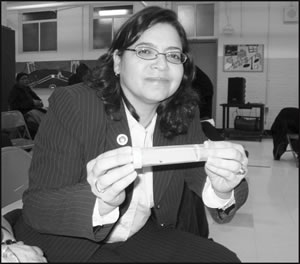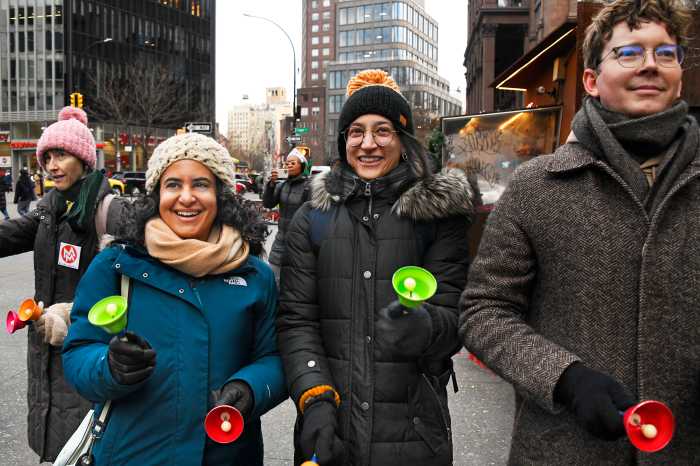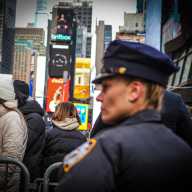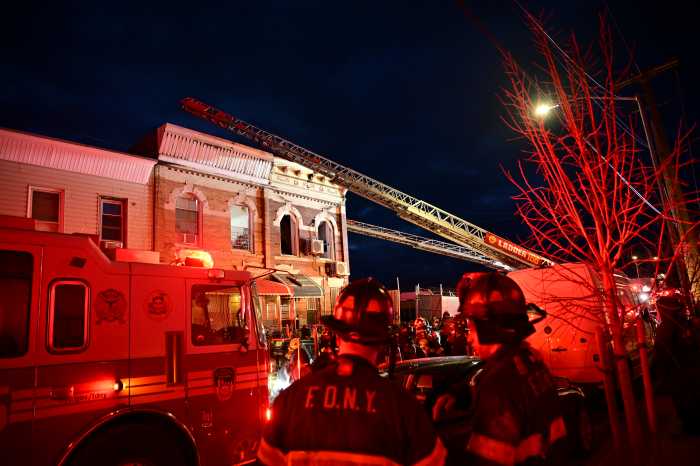By Lesley Sussman
In an effort to prevent the type of bedbug epidemic that swept the city in 2009, the Department of Housing Preservation and Development and the New York City Housing Authority joined forces last week with Councilmember Rosie Mendez, who co-sponsored two community forums on how to prevent and combat such infestations in one’s home.
The first forum was held Tues., Jan. 18, at Health Professions High School, 345 E. 15th St., and focused on residents living in private housing. The second forum, on Thurs., Jan. 19, was held at P.S. 188, 442 E. Houston St., and was geared to NYCHA residents.
Mendez, whose district includes the East Village, Gramercy, Union Square and part of the Lower East Side and reaches up to E. 35th St., said she was somewhat disappointed with the small turnout at both forums, but blamed inclement weather for the poor showing.
The councilmember said she initiated the series of forums because in the past year her office had been receiving a greater than normal amount of complaints about bedbugs.
“Just looking at what’s happening in the city and with all the news about bedbugs, I thought it was important to do these forums and bring in housing experts from the private housing stock and public housing stock to talk about procedures on how to identify them, what you can do on your own and, if you live in public housing, how to get management involved to do something about the problem,” she said.
The councilmember said that while she was “very happy” with the city’s participation in both forums, it was unfortunate there wasn’t a greater showing by residents.
“The most important thing here is education — people have to know how to prevent and combat bedbugs,” she said. “And once they know, they can pass that information on to their neighbors. So I was hoping for a larger turnout.”
At the Thursday night forum, which was attended by 15 residents — mostly from the Bernard Baruch, Lillian Wald and Samuel Gompers developments — Joseph Roeder, deputy director of NYCHA’s Manhattan Borough Office, said there was no evidence of an epidemic of bedbugs in public housing.
“This infestation is happening all across the city,” Roeder said. “But at the New York City Housing Authority, we’re not calling it an epidemic yet.”
He read off a list of NYCHA-run developments and the numbers of bedbug complaints received from each. He said that, in general, the number of such complaints were low.
Roeder cited the Baruch Houses as an example. He said there are 2,391 dwelling units in that development, but that only 152 bedbug complaints were received last year.
“That’s about 6 percent and the figures for the rest of the developments in Manhattan are pretty much the same,” he said.
Roeder noted, however, that the Housing Authority was somewhat short-staffed in pest control inspectors and exterminators.
“We only have 20 exterminators in Manhattan,” he said. “That’s one of our drawbacks. We only have two teams assigned every day just for bedbugs.”
The deputy director said his agency was working to correct the problem by hiring more outside contractors.
“This will help free up our own exterminators who are busy with rat and roach control,” he said.
Mendez called the staffing shortage understandable because, she said, the Housing Authority was “still going through a chronic fiscal crises.” The councilmember added, however, that she would look into the staffing issue both in Manhattan and the other boroughs and see if there is any way to increase the number of inspectors and exterminators.
Earlier in the forum, Jamal Rashid, technical services adviser for NYCHA’s Technical Services Department, discussed ways for residents to prevent bedbug infestation and how to safely get rid of the pests.
Rashid reassured public housing residents that while the dreaded, blood-hungry bedbugs are a nuisance, they are not known to spread disease. He said bedbugs can enter homes by latching onto used furniture, luggage and clothing, and by traveling along connecting pipes and wiring.
“Never bring bed frames, mattresses, box springs or upholstered furniture found on the street into your homes,” he cautioned residents. “You should also avoid buying refurbished and used mattresses and furniture. And if you suspect you have bedbugs, call your management office immediately”
Rashid strongly cautioned residents against trying to treat the problem on their own. The pest control expert said that excessive use of pesticides could lead to poisonings.
Some signs of bedbug infestations, he explained, include bloodstains on linen, dark stains on mattresses from bedbug waste, musky odors and bite marks. He said that bedbug bites can be very itchy and irritating and, in some cases, cause skin rashes and allergic reactions.
Mendez told residents to contact her office if they did not get a swift response to their bedbug complaints from their management office.
“We’ll follow up on it,” she said. “The New York City Housing Authority doesn’t want this to become an epidemic.”




































